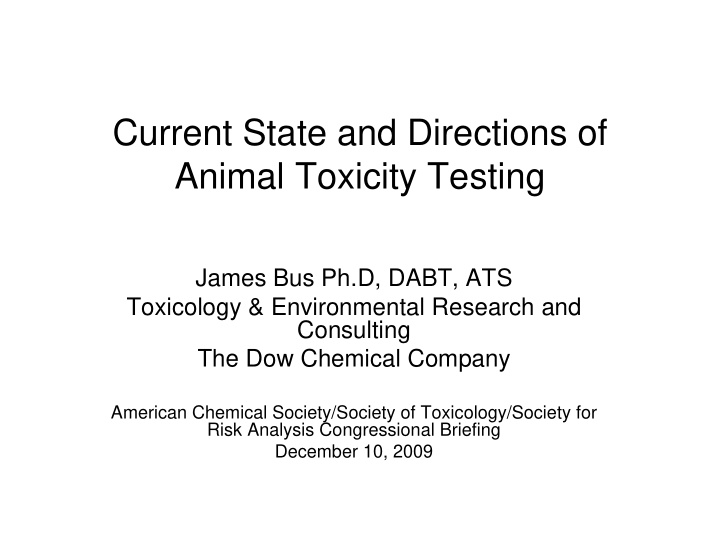



Current State and Directions of Animal Toxicity Testing James Bus Ph.D, DABT, ATS Toxicology & Environmental Research and Consulting The Dow Chemical Company American Chemical Society/Society of Toxicology/Society for Risk Analysis Congressional Briefing December 10, 2009
Drivers of Toxicity Testing • History of toxicity testing – Unexpected adverse health events in workers and general population – Society of Toxicology founded 1961 • Key regulatory initiatives (1970’s & beyond) – FIFRA (pesticides) – TSCA (industrial chemicals & pollutants) – REACH (Europe; industrial chemicals) • Product stewardship – “knowing your products”
Animal Toxicity Tests: Standard Battery • Acute (single dose, oral, skin, inhalation) • Genetic Toxicity ( in vitro and in vivo ) • Immunotoxicity/Sensitization • Subchronic dose (28-90 days; organ injury) • Chronic Toxicity & Cancer (lifetime) • Developmental Toxicity (birth defects) • Two-generation Reproductive Toxicity • Adult Neurotoxicity • Developmental Neurotoxicity
Animal Toxicity Testing: The Issues • Costly (~ $3-5MM for full battery) • Large numbers of animals required (> 12,000 for full battery) • Low through-put (> 4 yr to complete battery) – Full battery required only for pesticides – Thousands of non-pesticide chemicals in development and in commerce • Animal-to-human risk extrapolation uncertainties – Accounted for with use of conservative risk assessment defaults – “Mode-of-Action” evaluations used to reduce uncertainty in risk assessments
Reducing demands for full battery testing: Tier-based toxicity testing strategies From: Becker et.al. Fd.Chem.Toxicol. 45: 2454-2469, 2007
Refining Animal Toxicity Testing: Ongoing Emphases • Exposure-Dose considerations (“margins of exposure”) – Understand “delivered dose” to test animals (how much and what gets in) – Relationships of animal test doses to real-world human exposures: • Better understanding of: human uses, production volumes, human biomonitoring, exposure modeling, etc. • Structure-Activity-Relationships (“predictive” toxicology) • “Mode of Action” information – Human relevance of animal test findings • “Combination” test protocols – Extracting more “bang-for-buck” effects information from consolidated test protocols
Animal Toxicity Testing: Transitioning to 21 st Century Toxicity Testing Vision • Animal testing – provides extensive reservoir of knowledge framing future testing strategy – identifies complex whole animal determinants of toxicity outcomes • key drivers of dose-response • organ specific responses • multi-organ interactions driving toxicity expression – can be refined to incorporate newest technologies consistent with 21 st testing vision
Recommend
More recommend